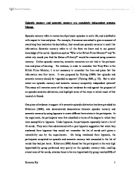Episodic and Semantic Memory Distinction
Explicit memory requires conscious recall, in other words the information must be called back consciously when it is required. If this information is about our own lives it is called episodic memory.Episodic memory allows a person to decide when, where and under what circumstances they experienced an event. A episodic memory test explicitely requires the participant to retrieve information about an earlier epsiode. If it concerns our general knowledge then it is called semantic memory. Semantic memory refers to conceptual knowlegde, independent of other contexts in which that knowledge was aquired. Semantic memory test can in priciple be performed without the need to retrieve information about any specific learning episode.
These two memory systems have been proposed by much evidence to be separate distinct memory stores, Tulving (1972) claims that differences in LTM are due to these distinct differences in episodic and semantic memory, such that semantic knowledge cannot aid episodic retrieval. Tulving suggested that the material is organised differently in each of these and that they have different susceptibilities to forgetting therefore each requires a different explanation. Episodic memory is lost rapidly, and new information arrives and interferes. It may be that semantic memory is constantly used, and it is rehearsed. . In this essay I am going to be discussing the extent to which this dissociation claim is true using evidence from blood flow in the brain, from amnesiacs, from experimental dissociations and simple transfer.
Wood et al (1975), found evidence for the distinction by a measure of the regional cerebral blood flow. They supported the distinction as significant correlations were found between accuracy of performance and blood flow in the occipital and tempral-occipital regions for the episodic recongition group, but not for subjects in the semantic recognition group. Similar findings were also reported by Tulving (1979) where he found an increase in blood flow in the back of the brain for semantic memories and in the front of the brain for episodic memories using radioactivity as a measure. However caution must be taken as Wood et al pointed out that it might be possible that the differences observed are attributable to differenced in the difficulty level of the task, rather than to their episodic and semantic characterization.
Explicit memory requires conscious recall, in other words the information must be called back consciously when it is required. If this information is about our own lives it is called episodic memory.Episodic memory allows a person to decide when, where and under what circumstances they experienced an event. A episodic memory test explicitely requires the participant to retrieve information about an earlier epsiode. If it concerns our general knowledge then it is called semantic memory. Semantic memory refers to conceptual knowlegde, independent of other contexts in which that knowledge was aquired. Semantic memory test can in priciple be performed without the need to retrieve information about any specific learning episode.
These two memory systems have been proposed by much evidence to be separate distinct memory stores, Tulving (1972) claims that differences in LTM are due to these distinct differences in episodic and semantic memory, such that semantic knowledge cannot aid episodic retrieval. Tulving suggested that the material is organised differently in each of these and that they have different susceptibilities to forgetting therefore each requires a different explanation. Episodic memory is lost rapidly, and new information arrives and interferes. It may be that semantic memory is constantly used, and it is rehearsed. . In this essay I am going to be discussing the extent to which this dissociation claim is true using evidence from blood flow in the brain, from amnesiacs, from experimental dissociations and simple transfer.
Wood et al (1975), found evidence for the distinction by a measure of the regional cerebral blood flow. They supported the distinction as significant correlations were found between accuracy of performance and blood flow in the occipital and tempral-occipital regions for the episodic recongition group, but not for subjects in the semantic recognition group. Similar findings were also reported by Tulving (1979) where he found an increase in blood flow in the back of the brain for semantic memories and in the front of the brain for episodic memories using radioactivity as a measure. However caution must be taken as Wood et al pointed out that it might be possible that the differences observed are attributable to differenced in the difficulty level of the task, rather than to their episodic and semantic characterization.







